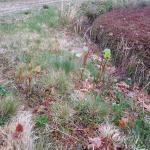With all the cool temperatures we have had this spring, most growers are planning to start sweeping next week (week of May 8). Sweeping this week only resulted in a very few weevil and many collembola/springtails (not a cranberry pest, but very abundant on bogs in many colors) – see attached pic. Coming next week, tiny blackheaded fireworm larvae of the most concern, green spanworm has likely hatched too. In your net, you may see cutworms such as blossomworm and gyspy moth.
Entomology is running an Insect IPM Clinic on May 16th (7:30-9:30) at the station.
Sweeping is essential early/mid-May and onward to detect hatch of blackheaded fireworm larvae. Training the eye to see the dingy larvae in the net is needed. It can be helpful to bring sweep samples inside and inspect on a lighted surface. The small larvae tend not to be picked up in sweeping owing to their webbing behavior so a few small larvae in spring sweeps signals a problem (action threshold is an average of 1-2 larvae per sweep).
A couple of sprays, perhaps 7-10 days apart to cover a typical asynchronous hatch, may be needed. Avaunt, Delegate, Intrepid, and Sevin are effective, but check with your handler for any restrictions of these compounds. Well-timed, good coverage sprays are effective but larval development is fast and that the larvae do not get much larger than 1/3 inch, so prompt attention to this insect is crucial.
Chlorothalonil sprays for upright dieback control are timed for when the bud has broken dormancy and new growth has begun. For most varieties and locations, this will be within the next 10 days. The first spray for Fairy Ring control is also timed for budbreak. A combination spray of Indar and Abound is recommended. Please see the Chart Book for details (p13 for URD and p22 for Fairy Ring).
Japanese Knotweed is up (actually has been for several weeks). Please see photos. The best approach to control JKW is to find it early and be persistent; control WILL take a long time. A shovel is the best option for young, individual plants. Once you have a patch, plan to treat at least twice per year: once in spring/summer (now) and once in early fall. Roundup is the herbicide of choice but remember you can only wipe or dab weeds on the bog; sprays are permitted in DRY ditches during the season or ON-BOG after harvest. Be sure that the glyphosate product you are using has these applications on the label.

 Japanese Knotweed (late April)
Japanese Knotweed (late April)
You can “cut and treat” with Roundup. Cut the stems and IMMEDIATELY apply the herbicide to the cut stem. Use a concentrated solution of Roundup if doing this method. You can dab (on-bog) or spray (off-bog) the cut stem, but if you spray, be sure there are no desirable plants in the area as RU will injury or kill those plants. Wait at least 7 days before mowing or re-treating; the herbicide needs time to move into the roots.
If the JKW is off-bog, you can also spray the leaves and stem with a 1-2% solution of Roundup. Again, be careful of injury associated with oversprays. If the JKW is NOT on the bog or within the bog system, you can use triclopyr (alone or with Roundup). There is no food tolerance for triclopyr so do NOT use on the bog.
Finally, we have gotten some questions about mixing QuinStar and Callisto as early POST sprays. Assuming this is desirable based on weed control goals, consider the following. Our jar test results indicated that these two do not combine well but it could work if the solution is constantly agitated. Please see the fact sheet for more info: https://scholarworks.umass.edu/cranberry_extension/153/.We did not include COC in our jar test evaluation. So, I would recommend mixing all 3 in a jar before using on your bog. Be sure to feel the jar after mixing. It should stay at room temperature; heating or cooling indicates a chemical reaction is happening and this is not good.
